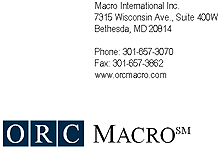|
September 19, 2006
Mr. Milton Brown Office of the Chief Counsel National Telecommunications and Information Administration 1401 Constitution Avenue, Room 4713 Washington, DC 20230
RE: Notice of Proposed Rulemaking and Request for Comment: Implementation and Administration of a Coupon Program for Digital-to-Analog Converter Boxes Federal Register: July 25, 2006 (Vol. 71, No. 142), pgs. 42067–42074
Dear Mr. Brown:
In response to the above referenced Federal Register notice, enclosed are comments regarding fraud prevention for the coupon program.
Sincerely,
Chris Bishop Vice President
Encl.
Comments on FRAUD AND ABUSE in THE Coupon Program for DIGITAL‑TO‑ANALOG CONVERTER BoxesFor a coupon-based system, there are two major potential sources of fraud. The first involves collusion, where the retailer conducts a cash transaction with a customer and then redeems the coupon (i.e., trafficking). No converters are purchased in this situation, and the retailer makes an unearned profit. The second involves overcharging for the item covered by the coupon. Instead of charging the market rate, the retailer increases the price. This is more likely to occur in places where there are few participating retailers.
In both of the above situations, the coupon-redemption process involves retailers. Some coupon redemption designs, however, may favor participant-only fraud and abuse.
The following strategies have been used to avoid or reduce fraud:
· Building protections into the coupon exchange and redemption system · Developing data mining routines that recognize suspicious situations · Developing an investigative capacity that allows for followup on cases of fraud and abuse Building Protections Into The Coupon Exchange And Redemption SystemThe best way to protect against fraud and abuse is to design a fraud-reduction system. From our experiences with the U.S. Department of Agriculture’s Food Stamp Program and Women, Infants, and Children Program, we have learned that selectively authorizing retailers reduces fraud. Fraud is least likely to occur when transactions occur between individuals and retailers who do not know each other. Large chain stores would require a dishonest staff member or possibly an insider contact in order for trafficking to occur. Smaller stores provide a less controlled environment where trafficking deals could be made. Although profiling retailers may be advantageous in terms of controlling the amount of trafficking, it may also raise legal concerns about the basis for selection. Electronic Redemption Versus Paper CouponsAn electronic system may be the most important element in reducing fraud because it more easily creates accountability and auditable records. However, it will not stop individuals who are determined to traffic. The major issue in instituting an electronic system (e.g., smart card) relates to how easily it can be implemented by retailers. For example, the Food Stamp Program subsidized Electronic Benefit Transfer system card readers in all stores. Whether the smart card (or similar technology) is compatible with electronic scanning devices used by participating retailers is a concern. Depending on how these cards are processed within the store, the program could detect a greater or lesser amount of fraud. It may also be the case that using smart card technology would require that electronic systems already be in place, thereby eliminating many smaller retailers. Also, for a program with a short duration, we are concerned about the potential for encountering technical problems with a smart card system. Ensuring CompetitivenessIncreasing competition among retailers may be the best solution for avoiding overcharging. Presented with a choice of retailers, consumers will likely select the one with the lowest price. Rural areas and areas in which consumers have limited access to retailers are more likely to have higher prices. It may be important to offer individuals online access to retailers in addition to “brick and mortar” stores. Controlling Access to CouponsIn this program, households will be restricted to one or two coupons; however, if controls are not provided to identify consumers, individuals can accumulate more than two coupons by providing false information. Food stamp, welfare, health plans, and similar programs prevent this type of fraud through relatively complicated certifying processes; however, those methods are not applicable to this program. A Web-based application process is difficult to control because of the ease of access and the anonymity of it. DEVELOPING DATA MINING ROUTINES THAT RECOGNIZE SUSPICIOUS SITUATIONSMost current systems have a real-time processing component that recognizes possible instances of fraud and abuse. For example, credit card companies include intelligent systems that monitor single transactions to determine whether they are suspicious. The intelligence may be built on logical filters or on behavioral filters based on outliers relative to an individual’s previous usage or ones relative to the usage of similar individuals.
Any real-time fraud and abuse system for this program should be implemented based on logical filters because there will not be enough history associated with coupon redemption over the short duration of the program. If the transactions are through paper coupons, fraud detection can occur only after the coupons have been transmitted by the retailer for redemption. Through smart cards, it may be possible to construct a logical system that helps detect suspicious activity closer to the time of the transaction. It is important to note that simply advertising the use of such a system may deter fraud and abuse.
Post-transaction data mining and analysis may help identify situations for followup after the conclusion of the program. However, developing procedures that include incentives for reporting instances of potential abuse may be more effective. DEVELOPING AN INVESTIGATIVE CAPACITY THAT ALLOWs for FOLLOWUP ON CASES OF FRAUD AND ABUSEInvestigations are generally covert actions to identify instances of fraud and abuse conducted by a large-scale investigative unit. For this program, investigations would be cost effective only for following up particular instances of fraud and abuse. It would be better to establish a whistleblowing capacity through which individuals or retailers can report instances of potential abuse. When substantial evidence is present, the case can then be referred to an agency such as the Office of the Inspector General. A data processing capacity and an interface may be needed to systematically identify these situations and track actions associated with them.
|

